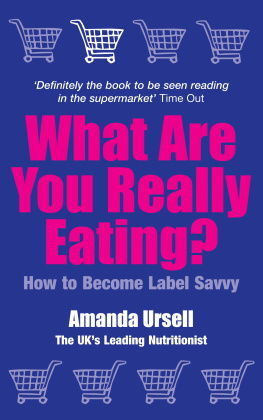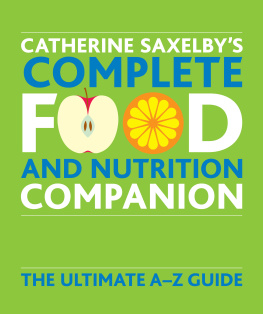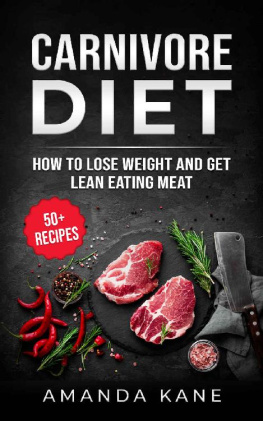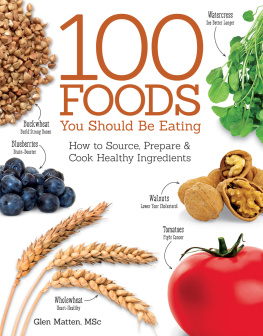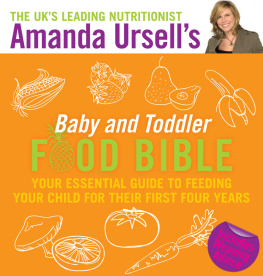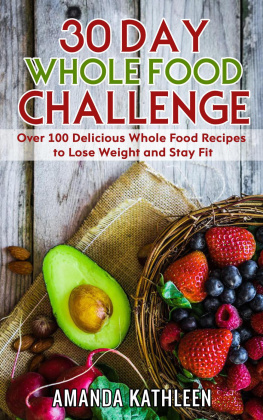Amanda Ursell, 2004, 2005
The moral right of the author has been asserted.
All rights reserved. No part of this book may be reproduced by any mechanical, photographic, or electronic process, or in the form of a phonographic recording; nor may it be stored in a retrieval system, transmitted, or otherwise be copied for public or private use other than for fair use as brief quotations embodied in articles and reviews without prior written permission of the publisher.
The author of this book does not dispense medical advice or prescribe the use of any technique as a form of treatment for physical or medical problems without the advice of a physician, either directly or indirectly. The intent of the author is only to offer information of a general nature to help you in your quest for emotional and spiritual well-being. In the event you use any of the information in this book for yourself, which is your constitutional right, the authors and the publisher assume no responsibility for your actions.
A catalogue record for this book is available from the British Library.
ISBN 9781401906887 in print
ISBN 9781848507722 in epub format
ISBN 9781848507715 in Mobipocket format
For Gerld and Nana
Contents
I would like to thank Michelle Pilley, Megan Slyfield and Jo Lal, at Hay House, who are a delight and revelation to work with. Thank you too to the wonderful Dr Beckie Long, a fab nutritionist and friend, who both helped me with some of the book research and read my proofs. Labelling is a complex issue and I appreciated your expert eye and encouraging words. I hope that Elliot, your little boy, was not too bored by listening to you read the proofs to him out loud!

If you have ever felt confused by the amount of information crammed onto a food label, then you are not alone and this is definitely the book for you. Ill let you into a secret Im a nutritionist and until I sat down to write this book, even I was bemused by some of the things I read.
When trying to make sense of labels it is first important to understand that they are there for two main reasons. From a practical point of view, they tell us the name of the food or drink we have picked up, which ingredients it is made from, its weight and where it comes from.
But labels are also there to encourage us to buy the product. They are like miniature adverts for themselves. It is their job to look as attractive and seductive as possible. The makers of foods and drinks do this by using bright colours and pictures, clever graphics and increasingly, these days, by highlighting their nutritional and health credentials.
By law, nothing on a food label is supposed to be misleading; however, at the moment, many claims about the nutritional or health benefits of a product occupy a rather grey legal area. Makers of foods and drinks stick, or are supposed to stick, to a set of voluntary guidelines. While in theory most of them do this, they also tend to make the most of their products good points, while avoiding drawing attention to their less than virtuous ones. I suppose it is no different to anyone trying to make the most of their assets.
Making the most of themselves
I always think that labels are a bit like our clothes and makeup. We try to buy clothes that suit us and to wear make-up and do our hair in ways that enhance our good points. Similarly, if the maker of, for example, a biscuit knows that his product is high in fibre, he will want to tell you this on his label. This is essentially not that different to us wanting to make the most of having legs like Julia Roberts, if we are lucky enough to possess them, or a waist as nipped-in as Nigella Lawsons.
However, although the biscuit label might have a special flash saying High in Fibre, the manufacturer would be a bit bonkers if he were also to draw our attention to the fact that his biscuits are also packed with fat, sugar and salt. Not highlighting these points, which are obviously going to deter many customers from buying the biscuits, is rather like not wearing something that you know is going to accentuate those bits of your body you would rather play down. Just as most of us know how to dress to disguise these things, food and drink manufacturers know how to disguise the worst features of their products and show them in their most appealing light.
You cannot blame them. They are in the business of selling food and drink, after all, and want us to buy as much as possible. And, for now, it is legal for them to market their foods in this way. But understanding why and how manufacturers do this is important if you really want to get to the nitty-gritty of what you are eating.
Going back to basics
With between 20 and 30,000 foods and drinks now on sale in an average supermarket, learning how to read a label will help to put you in charge of your trolley when shopping, and allow you to make informed choices about what you, and others in your home, eat and drink.
My Nana, who is now 96, tells me that in her day all food shopping involved a daily trip to local stores. To the baker for fresh bread made on his premises from scratch. To the greengrocer who popped carrots into a trusty string bag, and to the butcher who hand-wrapped a favourite cut of meat that was just enough for that nights dinner.
Today, we lead busy lives that mean we tend to do all our shopping in one go, under one roof in one supermarket, on a weekly or even monthly basis. Our shopping habits have changed; no longer do many of us walk around our local village or town buying bits and bobs from various specialized stores on a daily basis. Now we buy in bulk, and this means that most of the items we buy have in some way been processed before appearing on the supermarkets shelves. And since these foods come in packets, boxes, cans and bottles, it is just as well that, by law, they have to have a label. Labels on food have become a necessity.
What Are You Really Eating? is here to help you make sense of these labels, to give you the chance to really understand what you are feeding yourself and those around you.
So, whats on a label?
Labels may appear to be very different in shape and size, colour and design, and in what they tell us about the food or drink inside. But there are some things that are common to all labels that legally must appear.
For countries that belong to the European Union, like the UK, ultimately it is a group of bigwigs in Brussels who decide the laws that cover the labelling of their food. That said, here in the UK it is an organization called the Food Standards Agency who, in practice, handle things from a national perspective.
The key to tackling your shopping now and in the future is first to learn how to read the label. Then, perhaps most importantly, to learn how to interpret it. That means understanding, on the one hand, the information a manufacturer has to tell you by law, and on the other, the information he wants you to receive to encourage you to buy his product, rather than a similar one sitting right by its side.
Looking to the future
The powers that be over in Brussels are currently looking into various aspects of foodlabelling and there could be some changes in the next few years. The kind of areas being looked into for possible change include:

